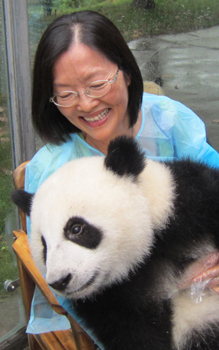 Growing up in a small village in China, Dr. Zhengxia Dou never had enough to eat. The collective commune system of living in her village made producing food nearly impossible during the drought and famine of her childhood.
Growing up in a small village in China, Dr. Zhengxia Dou never had enough to eat. The collective commune system of living in her village made producing food nearly impossible during the drought and famine of her childhood.
Dou and her family worked in the fields to help with the crops and tended the backyard chickens and pigs, doing everything by hand. No matter how hard they worked, there just wasn’t enough food.
“I was only a few years old, but I still have a memory of being hungry. Somehow, in the root of my memory, food is still a big deal,” said Dou, a PhD and Professor of Agricultural Systems at Penn Vet’s New Bolton Center. “I am still interested in food, but my focus now is on food production, food security, and the environment.”
In September, Dou returned to her birthplace with colleagues from the Center for Animal Health and Productivity (CAHP). The goal of CAHP is to help educate dairy farmers and corporations to improve cow nutrition, milk production, and environmental management. The trip to China was funded in part by the Provost’s Global Engagement Fund.
The New Bolton Center participants also included Dr. David Galligan, Professor of Animal Health Economics; Dr. James Ferguson, Professor of Nutrition and Section Chief of Animal Production Systems; Dr. Linda Baker, Staff Veterinarian, Animal Production Systems; Dr. Zhinguo Wu, Research Associate Professor of Ruminant Nutrition; and Dr. Robert Munson, retired CAHP Staff Veterinarian. In addition, Dr. Wen Shieh of Penn’s School of Engineering and Applied Science joined the group to bring an engineering technology perspective.
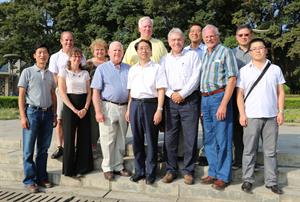 Also on the trip was top-rated Pennsylvania dairy producer, Walter Moore. Moore owns Walmoore Holsteins Inc., just a few miles away from the New Bolton Center campus. The Moore family has been working with Penn Vet for nearly 30 years. Moore credits the advice of Drs. Ferguson and Galligan with improving the efficiency of his farm. In only a few years, he has increased his herd 25 percent to 850 cows and his milk production 30 percent to 98 pounds per cow a day.
Also on the trip was top-rated Pennsylvania dairy producer, Walter Moore. Moore owns Walmoore Holsteins Inc., just a few miles away from the New Bolton Center campus. The Moore family has been working with Penn Vet for nearly 30 years. Moore credits the advice of Drs. Ferguson and Galligan with improving the efficiency of his farm. In only a few years, he has increased his herd 25 percent to 850 cows and his milk production 30 percent to 98 pounds per cow a day.
“China has a long way to go to catch up to the US industry,” said Moore, who visited several dairy farms with the Penn Vet team, some with thousands of cows and others with less than a couple hundred. At the Northwest Agriculture and Forestry University in Yangling, near the ancient Chinese capital of Xi’An, Penn Vet representatives met with more than 200 people, including farmers, faculty, veterinarians, nutritionists, and students.
The focus was on feed, specifically corn silage, which makes up the bulk of the dairy cow diet. Silage must be harvested and stored in a way that preserves the nutrients. The better the silage, Penn Vet experts say, the better the milk production.
"There are vast differences in quality of corn silage in China, and that really drives milk production. If the cows don’t have a quality feed, they are not going to make milk,” Galligan said. “That’s why we zeroed in on corn silage, to bring an awareness of the importance of that feed in their milking operations.”
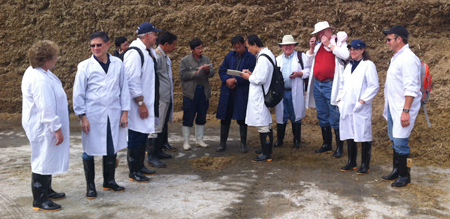
With new economic policies, China’s dairy business is expanding at an unprecedented pace. The growing middle class wants more animal protein, and the demand for fluid milk is growing steadily. With more than one billion people in China, the nascent dairy industry cannot meet demand.
Milk sells for twice the price in China than it does in the US, and the price of cattle is double, as well. As a result, the dairy farms are large and growing. Corporate Chinese dairies are setting goals of 10,000-cow herds. Despite having more than 12 million cows, compared to nine million in the US, China produces much less milk. In fact, the amount of milk each cow produces in China is less than half the average of a dairy cow in the US.
The Penn Vet team is trying to help Chinese producers better manage herds by improving the feed, which will, in turn, increase the milk production per cow. Better-managed herds also will reduce the negative impact on the environment.
“When I look at the US, a major reason our dairy industry has been able to evolve is due to the extension service that links science-based findings to on-farm application,” Galligan said. “In China there is not an infrastructure for that information. They rely on what they can find online or from consultants.”
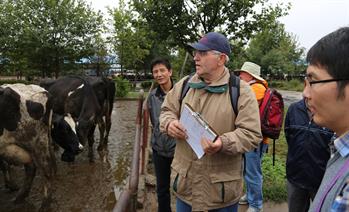 An ambassador in the effort to improve knowledge of dairy herd management is Ming Xu, Associate Professor at Inner Mongolia Agricultural University, another Penn Vet partner in China. Xu has been a fan of Penn Vet’s software for the dairy industry, the CPM Dairy Analyzer, and sought out Dr. Ferguson in 2010 when he was in China.
An ambassador in the effort to improve knowledge of dairy herd management is Ming Xu, Associate Professor at Inner Mongolia Agricultural University, another Penn Vet partner in China. Xu has been a fan of Penn Vet’s software for the dairy industry, the CPM Dairy Analyzer, and sought out Dr. Ferguson in 2010 when he was in China.
So enthusiastic is Xu about the possibilities to improve the Chinese dairy industry, he came to the New Bolton Center campus in December to study the US dairy industry.
“If the US dairy industry is like an adult, the Chinese dairy industry is like a toddler,” Xu said. “For China to make a big improvement, they need knowledge.”
That knowledge even extends to simple tasks such as milking a cow, which Moore demonstrated in China. “It made a big impact,” Xu said. “People in China are now copying the milking procedure.”
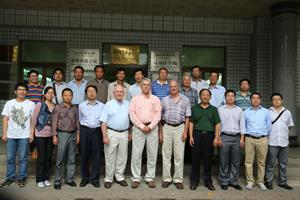 Penn Vet’s impact in China is far-reaching. Drs. Galligan and Ferguson are well-known at universities and in the dairy industry in China, Xu said.
Penn Vet’s impact in China is far-reaching. Drs. Galligan and Ferguson are well-known at universities and in the dairy industry in China, Xu said.
Galligan made his first trip to China for Penn Vet in 1985 and has returned several times. “During our September visit, we saw more progressive farms than we had seen before,” he said. “We saw some farms that had better corn silage and corn silage management systems than in years past.”
Penn Vet Dean Joan Hendricks also visited China last year with Dou, who has been working with the influential China Agricultural University in Beijing, giving seminars on Penn Vet’s work.
During Dean Hendricks’ visit, discussions began about more international collaboration. Changes may be made to the Penn Vet dairy curriculum to include additional externships in China for Penn Vet students, as well as the opportunity for students from China’s Inner Mongolia and Northwest Universities to come to Penn Vet.
“Food production is becoming a global business,” Galligan said. “It’s important that our students understand the potential of the dairy industry and gain a broad perspective of food production in the world.”
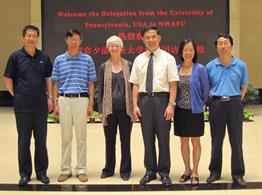 The possibilities in China are wide-ranging. Once import restrictions are lifted, the market for US farmers to sell young heifers will be very promising, with prices double those here. As soon as he returned from China, Moore started working with industry and government leaders to make those exports possible. “This could be a huge economic boon to the dairy industry,” Moore said.
The possibilities in China are wide-ranging. Once import restrictions are lifted, the market for US farmers to sell young heifers will be very promising, with prices double those here. As soon as he returned from China, Moore started working with industry and government leaders to make those exports possible. “This could be a huge economic boon to the dairy industry,” Moore said.
Seeking new opportunities has defined Dou’s life. She made it out of her village and to Yan’an University, where she majored in chemistry. She then studied the chemistry of soil at the Chinese Academy of Sciences before receiving her PhD from Penn State. Today, she may be the only soil scientist on faculty at a US veterinary school.
An integral part of the CAHP team, she studies food production as a cycle: how you feed the cow not only affects the production of the milk and meat, but also has a direct impact on the composition of the manure, which returns to the soil to nourish the corn that makes the feed.
Dou hardly recognizes the city where she grew up, where her 91-year-old father and four siblings still live. Her feelings are mixed, as significant growth has brought pollution to the air and water. The lack of education and awareness about the environment is overwhelming. That’s where she hopes she and her colleagues can make a difference.
“People are living much better lives,” she said. “You don’t see hungry people like before. These are big, big changes, but how to meet the growing demand for food in a sustainable way remains a tough challenge for all of us.”